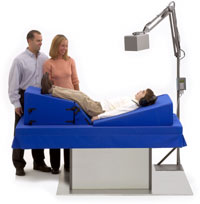
|
|
|
Click on the monitor below to see a recent news report on the Sensory Learning Program.
Click on the monitor below to learn about the Sensory Learning Program.
|
The
Dr. Bradley E. Habermehl, O.D. Michigan Autism Children on the autism spectrum crave sensory stimulation. The repetitive sensory activation of the Sensory Learning Program can help bring forward developmental patterns that have been delayed.  “An
open letter to DAN! Protocol Parents: My son, Jacob, had been on the DAN!
Protocol for two years when it became increasingly clear his severe sensory
issues needed to be addressed. In researching my options, I discovered the
Sensory Learning Program and its non-invasive approach to developmental
learning. The results speak for themselves: “An
open letter to DAN! Protocol Parents: My son, Jacob, had been on the DAN!
Protocol for two years when it became increasingly clear his severe sensory
issues needed to be addressed. In researching my options, I discovered the
Sensory Learning Program and its non-invasive approach to developmental
learning. The results speak for themselves:• When we arrived in Boulder on Jan 8th, 2002, Jacob had two words in his vocabulary. • By the end of our 12 days in Boulder, Jacob's vocabulary tripled. He even took a nap, which he hadn't done in over a year. He finally had a good night's sleep (so did I). • Eight months later, Jacob can count to 16, recite and recognize all 26 letters of the alphabet, and knows his shapes and colors. His eye contact is perfect. He has lost all his autistic traits! The only issue left is speech delay. And he's saying new words everyday! To every parent implementing the DAN! Protocol whose child has sensory issues, you MUST look into the Sensory Learning Program! They're a perfect fit!” --Angel, LA Non-Verbal Language Disorder / Asperger's Syndrome When verbal skills are strong, visual-vestibular and spatial reasoning skills can improve with the Sensory Learning Program because both the visual and vestibular systems are being engaged simultaneously in the sessions. “When our son was diagnosed with NLD (Non-verbal Learning Disorder), it felt as if our world had come crashing in. We didn’t know where to turn or what to do. Though he seemed to understand things when they were explained to him, he had a problem doing some of the simplest things- like riding a bike or running. In school, his drawings were so primitive that the other kids began to tease him. We watched his self-esteem slip, and his social skills seemed to take a tailspin. Worst of all, it looked like our son was giving up on himself. But we weren’t about to. I called the Sensory Learning Center and learned what the Sensory Learning Program could do for my son. It was the best call I’ve ever made.” --L.F., CO Acquired Brain Injury When an adolescent or adult acquires a brain injury, the brainstem area, which receives primary sensory messages often, loses its ability to process and integrate those messages effectively. The individual often becomes hyper-vigilant, responding to all sensory impressions. Repetitive sensory activation in the sessions can help the individual relearn to process and integrate sensory input. "After the Sensory Learning Program, it was easier to talk and think. I got my enthusiasm for life back! After a couple of years, I repeated the therapy with even more positive results." --J.K., CO, 52-year-old Developmental Delays  Sensory
stimulation naturally brings forth developmental patterns. When there are
delays, repetitive, unique sensory stimulation can allow developmental
milestones to emerge. Sensory
stimulation naturally brings forth developmental patterns. When there are
delays, repetitive, unique sensory stimulation can allow developmental
milestones to emerge.“Our son’s speech just took off! He was saying more and using new words. He could handle so much more because he was able to vocalize his thoughts and feelings.” --J.M., CO Birth Trauma Even in a newborn, when the nervous system experiences physical trauma the brain begins to function as if it has an acquired brain injury. The child responds to ordinary sensory information as though the sensory messages are signaling a trauma. When the child begins to process sensory information in a safe environment during the Sensory Learning Program, he/she integrates sensory information more efficiently. The child responds and relates to his/her environment in a more typical way.  “Our
main reason for coming to the Sensory Learning Center was because our son only
said two or three words at age three. Within the first two days of the program,
he started saying a few new words. And his vocabulary grew daily from then on.
It has been about six months since our visit and he now says at least 75 words
clearly! He says several more with some letters dropped off. He is also
combining three and four word sentences often. He had been in speech therapy and
some occupational therapy for almost a year before our visit, but I am certain
that our visit to the Sensory Learning Center is what has made the real
difference in his language and speech progress. Thank you!!!” --J.C., TX “Our
main reason for coming to the Sensory Learning Center was because our son only
said two or three words at age three. Within the first two days of the program,
he started saying a few new words. And his vocabulary grew daily from then on.
It has been about six months since our visit and he now says at least 75 words
clearly! He says several more with some letters dropped off. He is also
combining three and four word sentences often. He had been in speech therapy and
some occupational therapy for almost a year before our visit, but I am certain
that our visit to the Sensory Learning Center is what has made the real
difference in his language and speech progress. Thank you!!!” --J.C., TXBehavior Problems Children may try to cope or compensate when sensory skills are difficult or impossible for them to perform. They cannot regulate sensory input or sensory activity levels due to sensory overwhelm and the accompanying emotional frustration. Many behavior problems result because sensory messages are not processed and integrated accurately and efficiently. Sensory skills are learned, and when the brain reorganizes to process and integrate sensory messages more efficiently and accurately, sensory arousal in the environment produces more natural behavioral responses. “Our daughter’s most significant changes had occurred in her temperament and ability to self-regulate. She continues to be well adjusted in the areas of socialization and sharing which the Sensory Learning Program greatly contributed to.” --T.S., CO ADD / ADHD  An
individual’s proficiency to attend to a task depends on his/her ability to
regulate sensory input and sensory activity levels. Often children who have
difficulty with sensory skills exhibit behaviors that earn them these labels.
Many sensory messages process and integrate initially in the brainstem area.
This area must be functioning in an organized way to arouse the individual to
attend adeptly. An
individual’s proficiency to attend to a task depends on his/her ability to
regulate sensory input and sensory activity levels. Often children who have
difficulty with sensory skills exhibit behaviors that earn them these labels.
Many sensory messages process and integrate initially in the brainstem area.
This area must be functioning in an organized way to arouse the individual to
attend adeptly. “Our son can now tell a whole long story with a lot of detailed, complex speech. He is calmer and has easier transitions. His focus is better, too! At one point after the first 12 days, I gave him a worksheet and he filled it out. He just filled it out!” --A.D., CO Learning Enhancement Exercising the sensory systems simultaneously allows people to enhance their ability to multi-task and perform multi-sensory activities more efficiently and effortlessly. Sensory skills can become enhanced and can promote easier learning and improved performance. “Fortunately, a friend of my mom’s told us about Mary and the Sensory Learning Program. I decided to give the program a try, and I’m so happy that I took that chance! My life has taken a 180º turn. Now, I accomplish tasks. I focus on tasks easily; I feel emotions, and best of all, I am now happy and content with my life. I have the drive to accomplish more and the patience that I lacked before. I am not worried or anxious about the future. I know and understand what it feels like to be calm and sure about myself and my life.” --S.A., CO If you are considering the Sensory Learning Program for a child, click here. |
|
Send mail to
sensoryssf@sbcglobal.net with
questions or comments about this web site.
|